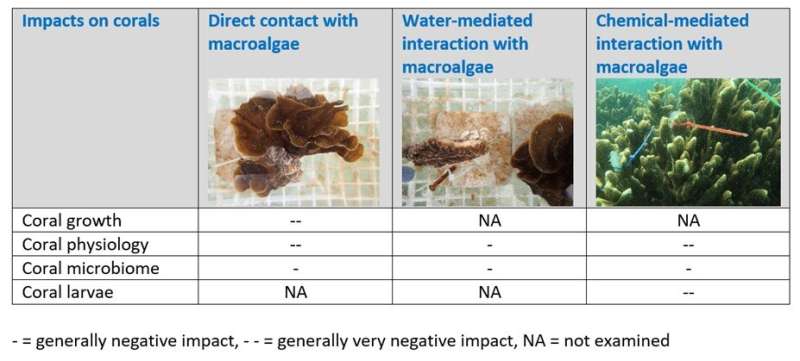Examining interactions between corals and macroalgae on Singapore's urban reefs

National University of Singapore marine ecologists studied the dynamics of interactions between corals and macroalgae (seaweeds) on Singapore's urban reefs and investigated the processes that mediate them, providing important insights on how our coral reef communities are structured.
The competition for space by corals and macroalgae is an important ecological process influencing and reflecting coral reef health. Under normal conditions, corals usually have an advantage, but disturbances caused by human impacts, such as increases in the nutrient level in the seawater, can drive a shift towards macroalgae growth. However, details on the factors affecting the intensities and outcomes of these competitive interactions are not well understood.
A three-year field survey on local reef ecosystems conducted by Prof Peter TODD and Dr. Jenny FONG from the Department of Biological Sciences, National University of Singapore, showed that the abundance and species of macroalgal neighbors are important factors in determining the intensity of the competitive interactions for space between corals and macroalgae. They also found that certain coral species experienced a decrease in growth rates when they are in direct contact with macroalgae.
Various macroalgae species produce chemical compounds to aid in their competition with corals for space. To explore the role of macroalgal chemicals on coral physiology and microbiomes, Prof Todd and Dr. Fong, together with researchers from Nanyang Technological University, conducted a series of aquarium- and field-based experiments. They found that microbiomes of certain corals were sensitive to both direct and water-mediated interactions with two of the seaweed species tested (Lobophora sp. and Hypnea pannosa), while coral physiology was compromised only when in direct contact with the macroalgae. Chemical compounds from the macroalgae Lobophora sp., Bryopsis sp., and Endosiphonia horrida were also found to increase the mortality rates of coral larvae.

Prof Todd said, "Findings from these studies contribute to the growing evidence that macroalgae generally have detrimental impacts on corals, although the impacts are variable among coral and macroalgal species. The research helps to improve our understanding of seaweed–coral dynamics on urban coral reefs, such as those found in Singapore."
More information: Jenny Fong et al, Spatio-temporal dynamics of coral–macroalgal interactions and their impacts on coral growth on urbanised reefs, Marine Pollution Bulletin (2021). DOI: 10.1016/j.marpolbul.2021.112849
Jenny Fong et al, Contact- and Water-Mediated Effects of Macroalgae on the Physiology and Microbiome of Three Indo-Pacific Coral Species, Frontiers in Marine Science (2020). DOI: 10.3389/fmars.2019.00831
Jenny Fong et al, Allelopathic effects of macroalgae on Pocillopora acuta coral larvae, Marine Environmental Research (2019). DOI: 10.1016/j.marenvres.2019.06.007
Journal information: Marine Pollution Bulletin , Frontiers in Marine Science
Provided by National University of Singapore



















